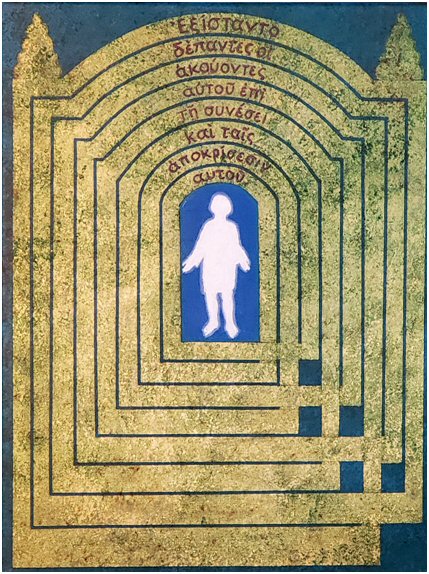|
The Artist's
Commentary
This painting shows the silhouette of a young boy standing in the center of an ancient, weathered and tarnished labyrinth. The labyrinth is a representation of a Jewish temple and the complexities of established Jewish religion. I have depicted the young boy as a living, breathing, and feeling human being -- in contrast to the cold, geometric design of the labyrinth. Jesus is radiant. He is alive; the labyrinth is a construction -- an artifice. The Greek writing at the top states that the authorities were amazed by his questions and answers.  There is the
implication that the boy Jesus saw the
limitations and weaknesses of the old, established
religious laws and the existing understanding of the nature of
God. There is the
implication that the boy Jesus saw the
limitations and weaknesses of the old, established
religious laws and the existing understanding of the nature of
God. Even so, Jesus is not being argumentative with the authorities in this scene. He is portrayed as one who is speaking gently and intelligently and respectfully and with great wisdom. The common interpretation of this story is it demonstrates how Jesus, even as a twelve-year-old boy, was deeply religious, with deep understanding and extraordinary knowledge of Jewish law and, most importantly, of God. Another way to look at the story is to focus on the relationship between a new understanding of spiritual matters in the context of established religious thought. It is the difference between a tradition based on the law and a new vision of God based on the spirit of the law. That distinction is especially important to us today. The way of the Christ is to debate differences peacefully. Jesus is not being judgmental. He shows a gentle, understanding nature. He is mainly asking questions which indicates he may have been using the Socratic method to debate a difference of understanding between Jesus and the teachers. It is only later that the He would stand against the established religious practices – practices which divided people into two separate camps: those who were said to be approved by God and those who were not. The so-called approved ones arrogantly asserted their assumed right to exercise judgment over others and condemn them for breaking established laws. During his teaching and preaching, Jesus would elaborate upon a new kind of religious practice – based not on enforcing laws which served to ostracize or condemn people but upon an understanding that promoted loving one’s neighbors. I believe it is our job to interpret the record of his words and actions so we can more fully understand the truth contained in his teaching. The important question is: how does this story apply to us today? Like Jesus, we are often faced with old, established religious beliefs that are needlessly hurtful, as opposed to demonstrating love for others as Jesus taught us. At one time, women were not permitted to pastor churches. Another longstanding example that we now see as a misinterpretation of the Bible was the belief that it was God's will for us to have separate churches for blacks and whites. How do we deal with these old ideas and beliefs that seem to be short-sighted in terms of what we know today?  CREATE A FREE ONLINE JOURNAL -- CLICK HERE or HERE 
    Copyright, James Bennett 2021 |
